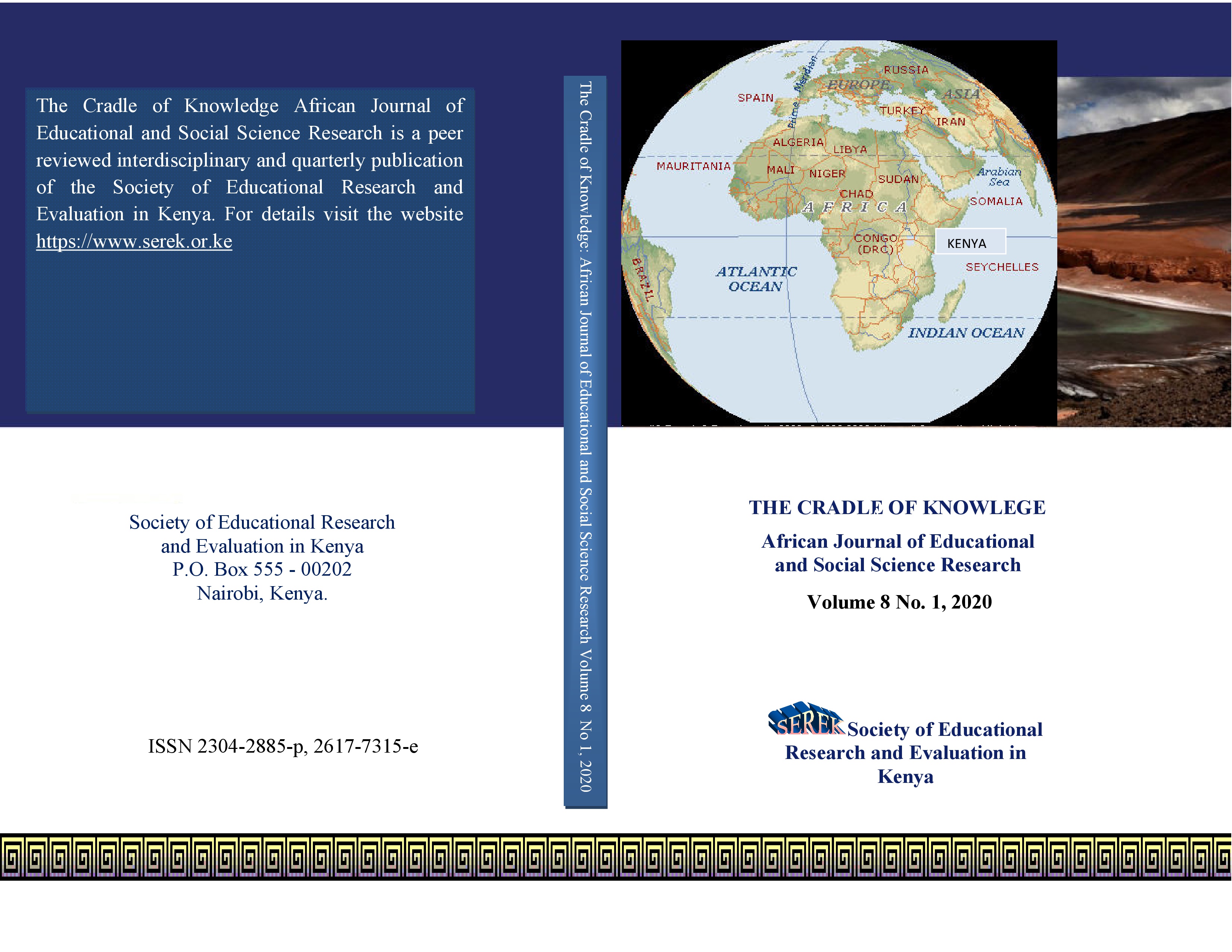
Strategies Used in Addressing Students’ Sexual Harassment in Selected Secondary Schools in Kiambu and Nyamira Counties, Kenya
Abstract
Sexual harassment (SH) is a ‘burning issue’ and a ‘silent problem’ among students in many learning institutions across the globe. Nonetheless, there is paucity of data documenting the different strategies used by schools to address this vice which is causing many students untold distress leaving them feeling upset and disappointed. In 2001, The United Nations Children Education Fund (UNICEF) expressed fear that unless something was done, student sexual harassment in secondary schools in Kenya would get out of hand as it was slowly registering itself as a growing vice. Certainly, several incidents of a sexual nature have been reported in Kenya’s print and electronic media and in field reports testifying to the growing nature of the vice in schools. This descriptive survey research study sought to establish prevalent forms of SH and strategies used by secondary schools to address high school students’ sexual harassment. The study, carried out in selected secondary schools in Nyamira and Kiambu Counties targeted 23,659 students, 678 teachers, 88 Deputy Principals and 88 Coordinators of Guidance and Counseling. Samples were obtained through purposive and proportionate random sampling techniques. Data was collected using questionnaires, interview and Focus Group Discussion (FGD) guides. Findings revealed that schools used varied strategies to address sexual harassment. Further, the findings revealed that besides school rules and regulations, most institutions preferred addressing SH through the guidance and counseling process. The study nonetheless recommended active stakeholder involvement with a view to stemming SH in schools.
Key Words: Sexual harassment, prevalent, forms, strategies, secondary schools.Full Text:
PDFReferences
American Association of University Women (AAUW) (1993). Hostile hallways: The AAUW survey on sexual harassment in America's schools. Washington, D.C. USA.
AAUW. (2001). Hostile hallways: Bullying, teasing and sexual harassment in school. Washington D.C. USA.
AAUW. (2002). Hostile hallways: Bullying, teasing and sexual harassment in school. Washington D.C. USA.
AAUW. (2006). Drawing the line: Sexual harassment on campus. Washington D.C. USA.
AAUW. (2011). Crossing the line. Sexual harassment at school. Washington D.C. USA
Apriliana, I. P. A. (2018). The role of school counsellor to handling student sexual harassment behaviour in the school. International Journal of Research in Education and Counselling. 1(2), 13–18. https://doi.org/10.24036/004za0002.
Bendixen, M., Daveroni, J. & Kennair, L. E. O. (2018). The effects of non-physical peer sexual harassment on high school students’ psychological well-being in Norway: Consistent and stable findings across studies. International Journal of Public Health, 63, 3–11 https://doi.org/10.1007/s00038-017-1049-3.
Bunyi, G. (2003). Interventions that increase enrolment of women in African tertiary institutions. Accra, Ghana.
Hill, C. & Holly, K. A. M. (2011). Crossing the line. Sexual harassment at school. AAUW, Washington D.C. USA
Hussin, J.H (2015). Sexual harassment in the workplace: An exploratory study from Lebanon. Journal of Management Research, 7 (1), 107-121.
Witkowska & Menkel, E. (2005). Perceptions of sexual harassment in Swedish high schools: Experiences and school environment problems. European Journal of Public Health, 15(1), 78-85.
Makura, A. H., & Shumba, A. (2009). Management of child sexual abuse cases by female school heads in Zimbabwe. Journal of psychology in Africa, 19 (1), 99-102 doi:10.10801/14330237.2009.10820264.
MOE (2008). Safety standards manual for schools in Kenya (1 st ed.). Nairobi, Kenya: Government Printer.
MOE (2010). What is sexual harassment? Nairobi, Kenya: Ministry of Education.
MOE (2011). Gender policy in education. Nairobi: Republic of Kenya.
Ondicho, N. K., Njuguna, F.W., & Kombo, K. (2019). Prevalence of Students’ Sexual Harassment in Secondary Schools in Nyamira and Kiambu Counties, Kenya. Researchjournali’s Journal of Education, Vol. 7 | No. 3 March | 2019 ISSN 2347-8225.
Republic of Kenya (2006). The Sexual Offenses Act no 3 of 2006.
Robinson, K. (2000) Great Tits, Miss! The silencing of male students’ sexual harassment of female teachers in secondary schools. A focus on gender authority. Discourse on studies in the cultural politics of education, 21 (1), 351-365.
Smit, D., & Plessis, D.U. (2011). Sexual harassment in the education sector. http/dx.doi.org/10.4314/pel.v1416.6.
Uduma, P. C., Samuel, E. S., Agbaje O. S. (2015). Prevalence and Forms of Sexual Harassment of Girls by Male Students of Secondary Schools in Ohafia LGA, Abia State. Science Journal of Public Health. Vol. 3, No. 3, 2015, pp. 433-444. doi: 10.11648/j.sjph.20150303.30
UNICEF (2004). Update of the situation assessment and analysis: Children’s and women’s rights in Nigeria. UNICEF: Abuja.
UNICEF (2016). Violence against children in education settings in South Asia. A desk review. UNICEF, Regional Office for South Asia (ROSA).
Ward, M. and Roger, H. (2018). Child sexual abuse in residential schools: A literature review. Independent inquiry into child sexual abuse, November 2018. Available at www.iiesa.org.uk
Witt, A., Rassenhofer, M., Brahler, A. E., Plener, P. L., & Fegert, J.M. (2018). The prevalence of sexual abuse in institutions: Results from population-based sample in Germany. https://doi.org/10.1177/1079063218759323.
World Health Organization, WHO. (2002). World report on violence and health, Geneva: World Health Organization.
World Health Organization, WHO. (2008). World report on violence and health. Chapter 6: Sexual violence. Geneva: World Health Organization. www.citizentvnews.co.ke
Refbacks
- There are currently no refbacks.
License URL: https://www.serek.or.ke
SEREK publication https://serek.or.ke
This work is licensed under a Creative Commons Attribution 4.0 International License